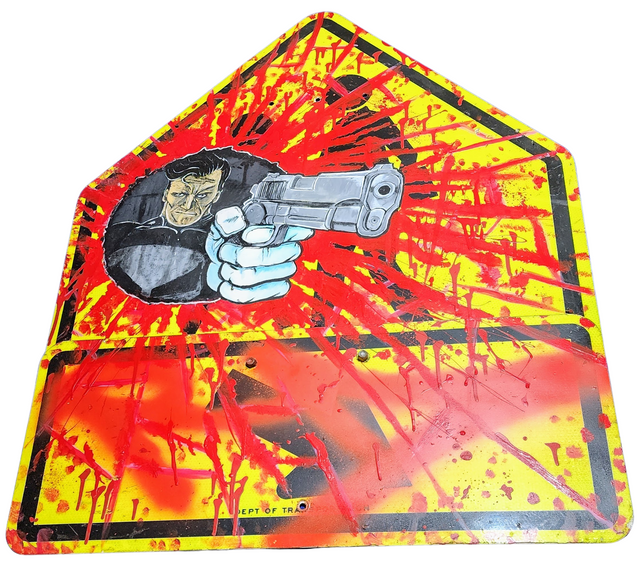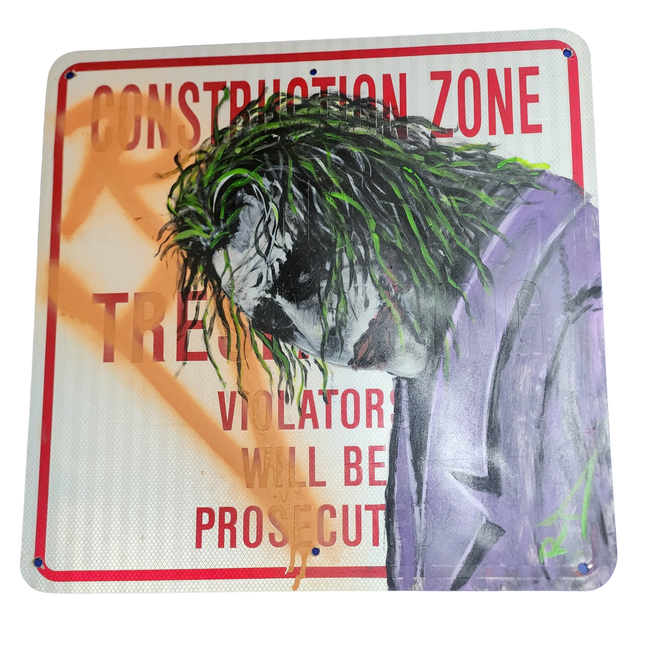
Street Signs
-

Shepard Fairey- OBEY Peace & Freedom Dove Metal Street Sign Print by Shepard Fairey- OBEY
Peace & Freedom Dove Metal Street Sign Limited Edition 2-Color Silkscreen Print on Street Sign Material Graffiti Modern Pop Art by Artist Shepard Fairey x Beyond The Streets. 2021 Metal Reflective Street Sign With Attached Signed COA Edition of 350 Size 24x24
$1,497.00
-

RD-357 Real Deal Ledger Joker Construction Street Sign Painting by RD-357 Real Deal
Heath Ledger Joker Construction Zone Original Street Sign Painting by RD-357 Real Deal One of a Kind Artwork on Real Metal NYC New York Construction Zone No Trespassing Street Sign by Graffiti Art Pop Artist. 2012 Signed Mixed Media Acrylic & Spray Paint on Reclaimed NYC New York Construction Zone No Trespassing Sign Painting Original Artwork Size 24x24 Batman Villian Played by Heath Ledger in the Movie as Joker Looking at the Viewer. RD Tag in Rust Red. RD-357's Heath Ledger Joker: A Fusion of Street Pop Art and Iconography The Heath Ledger Joker Construction Zone original street sign painting by RD-357, also known as Real Deal, encapsulates the essence of street pop art through its provocative use of public signage repurposed for artistic expression. Created in 2012, this mixed media acrylic and spray paint artwork transforms a New York City construction zone 'No Trespassing' sign into a canvas, depicting the iconic Batman villain played by Heath Ledger in a way that both challenges and captivates the viewer. Contextualizing RD-357's Artistic Approach RD-357, an artist whose real name remains elusive in the true spirit of street art anonymity, is known for his gritty interpretations of pop culture figures on unconventional canvases. This particular artwork measures 24x24 inches and is a testament to street art's versatility, pushing beyond traditional boundaries. RD-357 draws upon the anarchic spirit of the Joker, using a symbol of law and order – a construction sign – to present an image of chaos and rebellion. The irony is palpable; the sign, which once stood as a warning against unauthorized entry, now invites viewers to engage with the art in a personal, almost aggressive manner. Symbolism and Impact in RD-357's Joker Artwork This piece is not just a portrait; it is a statement. By choosing Heath Ledger's Joker, RD-357 taps into the collective consciousness of a society fascinated by the anti-hero archetype. Ledger's portrayal of the Joker was posthumously celebrated, and his death in 2008 left a cultural imprint that RD-357 leverages in this artwork. The juxtaposition of the Joker’s figure against the backdrop of a New York construction sign speaks volumes about the chaotic undercurrents within the perceived order of urban life. The use of mixed media, with acrylic and spray paint, highlights street art's raw, visceral nature, while also paying homage to the vibrancy of pop art. The viewer is confronted with the Joker's gaze, which, coupled with the bright warning colors of the construction sign, creates an unsettling yet magnetic presence. This interaction compels the audience to contemplate the layers of meaning behind the piece – from transforming public property into a medium for personal expression to the dialogue between art and spectator that challenges societal norms and the very definition of public space. In conclusion, RD-357's Heath Ledger Joker on a New York City construction sign is an outstanding example of how street pop art can merge cultural iconography with subversive messaging. Through this piece, the artist immortalizes a beloved film character and raises questions about authority, ownership, and the role of art in public discourse. The artwork remains a one-of-a-kind testament to the power of graffiti art to redefine spaces and provoke thought long after the paint has dried.
$2,626.00



